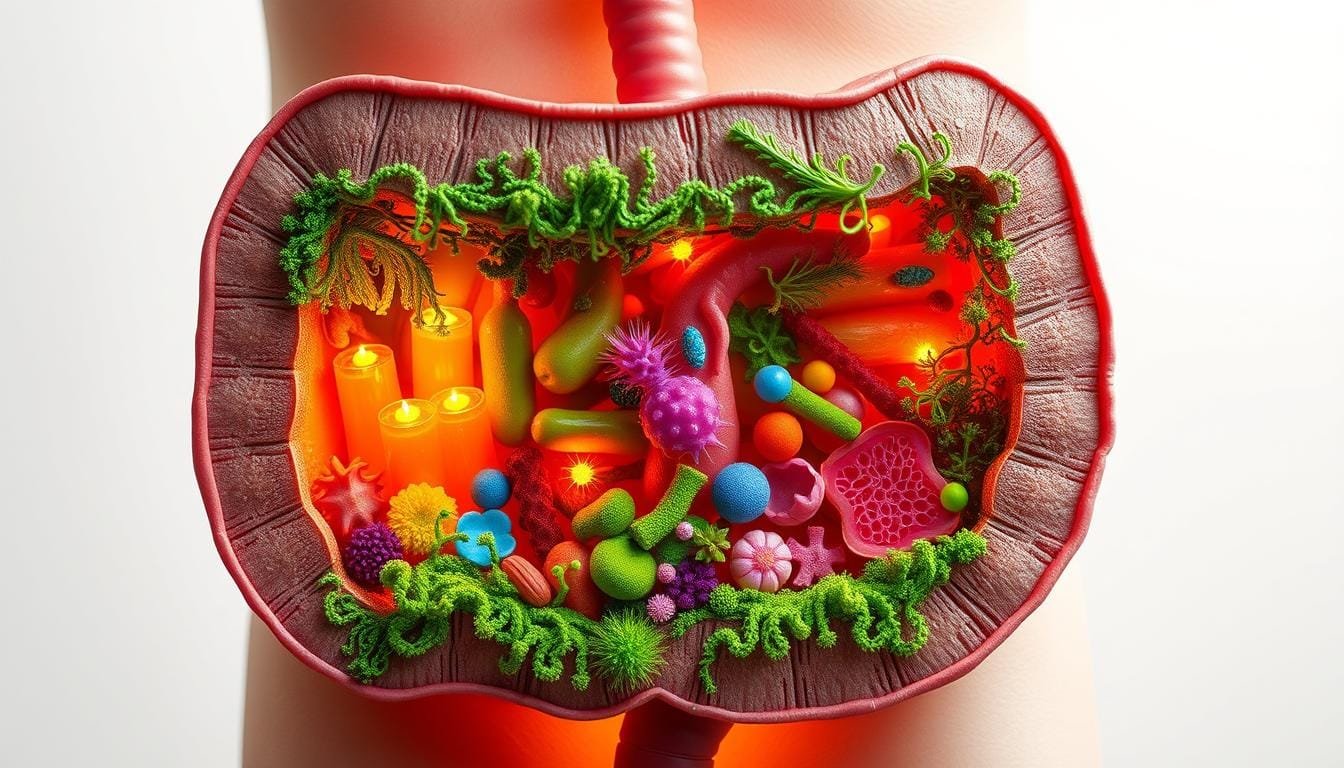Currently Empty: RM0.00
Surprising fact: studies show some of these biotics can help mood, sleep, and metabolic markers beyond digestion, affecting millions of people worldwide.
Wellness Concept opens a clear guide for readers in Malaysia who want smarter gut choices today. This short intro explains roles, limits, and why labeled products with “live and active cultures” matter.
Not all fermented foods meet the strict ISAPP definition for live strains. This piece will define each biotic, show how they work in the microbiome, and highlight practical benefits and real limits.
For local help, Malaysians can reach Wellness Concept on WhatsApp at +60123822655 during business hours: Mon-Fri 9:30 am–6:30 pm, Sat 10 am–5 pm. They provide friendly, evidence-minded guidance.
Key Takeaways
- Clear definitions help shoppers spot true live-culture products.
- These biotics work with the microbiome to support digestion and immunity.
- Evidence shows benefits beyond the gut, but research is still growing.
- Prioritize a varied diet and informed, strain-labeled choices.
- Individual responses vary; local support is available via WhatsApp.
- Practical tips will follow for choosing what fits each goal.
At a glance: probiotics, prebiotics, and postbiotics defined for today’s gut health landscape
Clear, expert-backed definitions make it easier for shoppers to judge product claims and match choices to personal goals.
Below are concise, ISAPP-style definitions and a short look at how these elements act inside the gut.
ISAPP-backed definitions and why they matter
International scientific association statements standardize terms so labels mean the same thing across products.
- Live strains: live microorganisms shown to provide a health benefit when taken in adequate amounts.
- Selective substrates: ingredients that specific microbes use to support host health.
- Inactivated products: non-living microbial components or preparations that still deliver benefits.
How these “biotics” interact within the gut microbiome
Substrates feed beneficial microbes; live strains can add targeted functions; and metabolism produces bioactives like short-chain fatty acids.
Present-day research: what’s solid vs. still emerging
Good evidence supports use for certain digestive issues and improved mineral absorption. Broader mental health and systemic effects are promising but need larger, strain-specific trials.
| Role | Main action | Current evidence | Consideration |
|---|---|---|---|
| Live strains | Introduce beneficial microbes | Support for some digestive conditions | Strain-specific effects; check label |
| Selective substrates | Fuel resident microbes | Linked to better mineral absorption | Dose and type matter |
| Inactivated components | Deliver bioactive metabolites | Emerging evidence for barrier and immune effects | Useful when live strains are unsuitable |
Probiotics explained: live beneficial microorganisms and their targeted effects
Live microbial products must meet strict criteria to claim health effects and reach the gut alive. ISAPP (International Scientific Association for Probiotics and Prebiotics) defines them as live microorganisms that, when given in adequate amounts, confer health benefits. Labels that show strain names and CFU at end of shelf life help verify this.
International scientific association definition
The association probiotics wording stresses both “live” and “adequate amounts.” This means a valid product lists strain IDs and evidence-based use. Without that, a claim is weak and may not deliver real health benefits.
Common genera and strain fit
Lactobacillus and Bifidobacterium are among the most used. Different strains suit different conditions, so matching a strain to an intended use matters.
For example, some strains help with irritable bowel syndrome while others reduce antibiotic-associated diarrhea. Not every bacteria strain is interchangeable.
Evidence highlights and real-world results
High-quality study data supports use for IBS and for lowering antibiotic-linked diarrhea risk when proper strains and doses are used.
A 2022 Cochrane review found fewer upper respiratory infections with regular use, showing benefits can extend beyond digestion.
Reading labels: not all fermented foods qualify
Yogurt, kefir, kimchi, and kombucha may contain live cultures, but only products that list “live and active cultures” and strain names meet probiotic standards. Supplements are popular because they can guarantee survival through processing and gastric transit.
For tailored probiotic recommendations in Malaysia, contact Wellness Concept on WhatsApp at +60123822655 during business hours.
Prebiotics unpacked: the selective fuel your beneficial microbes prefer
Selective dietary substrates act as a targeted fuel that helps beneficial gut microbes thrive. They are defined by one key rule: a substrate must be used selectively by helpful microbes and deliver a clear health benefit.
Not every fiber qualifies. Some fibers are general food for many bacteria, while true prebiotics feed specific ones. Ingredient lists may show names like inulin, fructo-oligosaccharides, or galacto-oligosaccharides rather than the word “prebiotics”.

Everyday sources and practical choices
Common foods that supply these substrates include onions, garlic, bananas, chicory root, oats, barley, asparagus, and beans. Oats are notable: a 2021 study gave 80 g/day and reported lower total and LDL cholesterol after 45 days, likely from beta-glucans and shifts in beneficial bacteria.
Health effects worth noting
Benefits can include improved mineral absorption, metabolic support, and gut-brain communication. For example, 12.5 g/day polydextrose for four weeks modestly improved attention and flexibility in cognitive tests, hinting at diet-driven signals between gut and brain.
| Feature | What to look for | Practical tip |
|---|---|---|
| Selective use | Inulin, FOS, GOS | Check ingredient list for these names |
| Food sources | Onion, garlic, bananas, oats, legumes | Include small portions daily, ramp up slowly |
| Health links | Mineral absorption, cholesterol, cognition | Pair with varied nutrition and regular meals |
Shopping note: labels may hide these nutrients under technical names. For help adding prebiotic-rich foods to a Malaysian meal plan, message Wellness Concept on WhatsApp at +60123822655 during business hours.
Postbiotics clarified: byproducts and inactivated microbes with real benefits
Modern science now recognizes preparations made from inanimate microorganisms and their metabolites as a useful tool for gut care. ISAPP’s consensus calls this a clear definition: inactivated cells or their components can deliver measurable benefits.
From metabolites to inactivated cells
These preparations include short‑chain fatty acids, heat‑killed strains, and cell fragments. They act without live organisms and may suit those who cannot take live options.
Physiological actions in the body
“Postbiotic components can strengthen barrier function, reduce inflammation, and support immune responses.”
- Support intestinal barrier and reduce permeability.
- Anti-inflammatory and antioxidant effects that ease discomfort.
- Help water and electrolyte balance for regularity.
| Action | Evidence | Practical note |
|---|---|---|
| Barrier protection | Lab and small clinical studies | May reduce “leaky gut” markers |
| Immune support | Markers of inflammation improved | Helpful alongside balanced diet |
| Hydration handling | Functional studies on absorption | Useful during mild gut upset |
Certain fermented foods and slow‑fermented breads can contain these components, but content varies by preparation. For product insight tailored to Malaysian lifestyles, message Wellness Concept on WhatsApp at +60123822655 during office hours.
Probiotics Prebiotics Postbiotics: What’s the Difference
A practical way to compare options is to split them into live organisms, the foods those organisms prefer, and the non‑living molecules that then act on the host.
Live microbes vs. their preferred substrates vs. resultant bioactives
Live products add beneficial microorganisms to the gut and can target certain conditions like antibiotic‑associated diarrhea or some IBS symptoms.
Selective substrates feed resident beneficial species and can support regularity, mineral absorption, and metabolic markers.
Inactivated bioactives include short‑chain fatty acids and heat‑killed cells that may help barrier function and immune responses when live options are unsuitable.
When to choose which: goals, symptoms, and product formats
Choice depends on goals and symptoms. For acute digestive upset, targeted live strains may help. For metabolic aims or slow shifts, selective substrates can be useful. For sensitivity or immune concerns, non‑living bioactives can be an option.
Formats include fermented foods, capsules, powders, and drinks. Each varies in stability, dose control, and convenience.
Synbiotics: pairing for complementary action
- Core point: live strains, selective fuel, and inactivated molecules each play a distinct role in gut balance and function.
- Synbiotics combine live strains with matching substrates to boost survival and activity.
- Match strain and dose to target effects; generic products may not deliver condition‑specific benefits.
For personalized product pairing advice in Malaysia, message Wellness Concept at +60123822655 during business hours.
Food-first approach: practical sources and Malaysian-friendly choices
Begin with food: everyday meals offer simple, reliable ways to support gut health. Small swaps deliver real benefits and fit local tastes.
Probiotic-rich options
Yogurt and kefir labeled with “live and active cultures” are good starts. Kimchi, tempeh, and some kombuchas can also supply viable bacteria when strain names and counts are shown.
Note: not all fermented food contains qualifying probiotic strains. Check labels for strain IDs and viability.
Prebiotic-rich pantry
Build a pantry with oats (beta-glucans), barley, asparagus, onions, garlic, bananas, and legumes. These foods feed beneficial microbes and add key nutrients to a balanced diet.
Postbiotic-containing foods and preparations
Explore sauerkraut, buttermilk, and slow-fermented breads for non-living bioactives that may support the body. Content varies by method, so variety helps.
“Start with food, rotate items, and choose minimally processed options to protect viable cultures.”
- Combine oats at breakfast, kimchi at lunch, and garlic-rich dinners.
- Rotate foods to broaden microbial exposure and substrates.
- Choose minimally processed items; heat and storage reduce viable cultures.
For local product suggestions and meal ideas, Malaysians can WhatsApp Wellness Concept at +60123822655 during business hours.
Supplements and product labels: choosing wisely and using safely
Choosing a supplement starts with reading its label like a small clinical report. This helps buyers see if a product matches a clear health goal and avoids wasted spending.
Match strain to condition and verify CFU, strain ID, and evidence
Look for full strain IDs (for example, Lactobacillus rhamnosus GG) and a documented CFU at end of shelf life. These details show intent and allow cross-checking with published evidence.
Match strains to goals: a strain supported for antibiotic‑associated diarrhea may not help other issues. Independent resources track which strains have clinical support.
Regulatory reality: why professional guidance can help
Manufacturers do not need preapproval from the U.S. FDA for efficacy, so product claims vary widely. That creates a risk for buyers who rely on marketing alone.
- Read storage instructions—heat and humidity lower live counts.
- Prebiotics may appear as inulin, FOS, or GOS; check dose and start slowly.
- Postbiotic labels should state composition (heat‑killed strains or metabolites).
“When in doubt, seek professional guidance to align evidence with personal health and medications.”
For label walkthroughs and safe-use tips, Malaysians can chat with Wellness Concept on WhatsApp at +60123822655 (Mon–Fri 9:30 am–6:30 pm, Sat 10 am–5 pm).
Safety, risks, and who should be cautious
A sudden change in fiber or supplements can trigger new gut symptoms for many people. Start slowly and watch how the body reacts.
Digestive sensitivity and high-fiber introductions
Rapid increases in high-FODMAP or selective fibers often cause gas, bloating, constipation, or diarrhea. Those with irritable bowel syndrome or suspected SIBO should be especially careful.
Practical tip: ramp up slowly, increase fluids, and pause if symptoms worsen.
Vulnerable groups and live microbial products
Live supplements can be safe for most adults, but they carry a higher risk for people with weakened immune systems, severe illness, or after surgery.
Postbiotics may be a gentler option since they do not introduce live bacteria, yet professional advice is still important.
Why balanced foods matter more than any single pill
A varied diet of fruits, vegetables, whole grains, and legumes supports microbiota long term. Supplements cannot replace poor eating patterns.
“Monitor responses and adjust; what helps one person may not suit another.”
- Keep product timing and total load in mind to reduce confusion over which ingredient causes symptoms.
- If antibiotics are needed, plan recovery with food-first strategies and targeted choices when advised.
Malaysians with medical conditions should consult a professional. Message Wellness Concept on WhatsApp at +60123822655 during business hours for general guidance before purchasing.
Wellness Concept Malaysia: friendly guidance for better gut health
Finding the right product or meal plan for gut comfort can feel overwhelming for many people.
Wellness Concept offers local, friendly advice to help Malaysians sort claims from useful options. They focus on diet first and practical choices that match health goals and sensitivities.

Chat on WhatsApp at +60123822655 for product insights tailored to your needs
Message them for label explanations, product comparisons, and plain-language steps. They will help decode strain IDs, CFU, and realistic benefits so people can decide with confidence.
Business hours
Monday–Friday: 9:30 am–6:30 pm. Saturday: 10:00 am–5:00 pm. Sunday: Closed.
| Service | What you get | Best for |
|---|---|---|
| Product comparisons | Side‑by‑side label review and clear pros/cons | Shoppers comparing supplements or foods |
| Personalised advice | Recommendations that fit diet and sensitivities | People with specific gut goals or reactions |
| Family meal ideas | Malaysia-friendly recipes to support balance | Parents and households |
| Ongoing support | Follow-up checks as needs or products change | Anyone starting a new routine |
- Plan a chat: bring product labels or meal details for faster help.
- Focus on food first: simple diet steps often give lasting benefits before buying products.
- Honest timelines: expect realistic advice on likely benefits and when to reassess.
Conclusion
,When choices are intentional, each gut-focused option can add a distinct, useful effect.
Probiotics offer live, strain-specific benefits for some digestive and infection-related outcomes. Prebiotics supply selective substrates that support mineral uptake and metabolic shifts. Postbiotics deliver inanimate molecules that help barrier integrity and immune response.
Start with food-first nutrition and steady, varied fibers to build microbiome resilience. Add targeted products only when a clear goal exists and labels list strains and doses. Small, repeatable habits beat large, short-lived changes for lasting balance and gut function.
Next step: Malaysians can WhatsApp Wellness Concept at +60123822655 for friendly, no-pressure guidance tailored to needs.
FAQ
What are the basic roles of live cultures, fermentable fibers, and microbial byproducts in gut health?
Live cultures act as beneficial microbes that can temporarily colonize and support digestive balance. Fermentable fibers serve as selective fuel that helps those microbes thrive. Microbial byproducts include metabolites and inactivated cell components that influence gut barrier integrity, inflammation, and immune signaling.
Why do ISAPP definitions matter when choosing a product or food?
ISAPP provides standardized, evidence-based definitions that help people and clinicians distinguish between validated supplements and general fermented foods. Those definitions make label claims clearer and guide research translation into practical recommendations.
Which genera and strains have the strongest clinical evidence for common conditions?
Research often highlights Lactobacillus and Bifidobacterium strains for antibiotic-associated diarrhea and some forms of irritable bowel syndrome. Specific strain-level identification and dose matter, so look for products that list strain IDs and clinical data matching the target condition.
Can fermented foods be assumed to provide the same benefits as supplements?
Not always. Some fermented items contain live, beneficial microbes, but only products labeled with “live and active cultures” and strain details offer confidence. Many fermented foods provide nutrients and metabolites that support health but may lack clinically proven strains or dosages.
What foods naturally supply fermentable substrates to support a healthy microbiota?
Everyday options include onions, garlic, bananas, oats, chicory, asparagus, and legumes. These foods contain fibers like inulin and fructooligosaccharides that selectively feed beneficial microbes and support mineral absorption and metabolic health.
How do microbial metabolites and inactivated cells help the body?
Metabolites such as short-chain fatty acids strengthen the intestinal barrier, reduce inflammation, and modulate immune responses. Inactivated cells and their components can also interact with gut tissues to produce protective and regulatory effects without live organisms.
When should someone choose a live-culture product versus a fiber-focused option or a postbiotic?
Choice depends on goals. Live-culture products may help with specific infections or antibiotic recovery. Fiber-focused options support long-term microbial diversity and metabolic health. Postbiotic preparations might suit those seeking immune or barrier benefits without introducing live organisms.
What is a synbiotic and when is it useful?
A synbiotic combines a live strain with a compatible fermentable substrate to enhance survival and activity. These pairings can improve colonization and function when the strain and substrate are matched based on evidence.
Which accessible foods provide live beneficial microbes for everyday diets?
Yogurt with live cultures, kefir, tempeh, sauerkraut made without pasteurization, kimchi, and some traditionally prepared kombucha can supply live microbes. Strain composition varies, so choose products that disclose culture information if targeting a specific effect.
How should someone read labels to choose a high-quality supplement or product?
Check for clear strain identification, colony-forming unit count at the end of shelf life, storage instructions, and published clinical evidence for the indicated use. Third-party testing and transparent manufacturing details add confidence.
Who should exercise caution with these interventions?
People with weakened immunity, recent major surgery, or central lines should consult a clinician before using live-culture products. Those with sensitive digestion may need to introduce fermentable fibers gradually to limit gas and bloating.
Can a balanced diet replace supplements and specialty products?
A varied, fiber-rich diet remains foundational. Whole foods support microbial diversity and overall nutrition. Supplements and specialized preparations can add targeted benefits for specific conditions or recovery phases when used appropriately.
How quickly can someone expect symptom changes after starting a product or diet change?
Responses vary. Some people notice digestive shifts within days; clinical benefits for conditions like IBS may take several weeks. Long-term dietary patterns yield the most durable changes in microbial composition and metabolic outcomes.
Are there regulatory or evidence considerations consumers should know?
Regulatory standards differ by country. Consumers should prioritize products with transparent labeling, peer-reviewed research, and professional guidance when treating health conditions. Professional associations and scientific reviews help interpret the evidence.
How can someone in Malaysia get tailored guidance or product information?
Wellness Concept Malaysia offers friendly support by WhatsApp at +60123822655 during business hours: Mon–Fri 9:30 am–6:30 pm and Sat 10 am–5 pm. Staff can help match products to needs and explain local choices.



